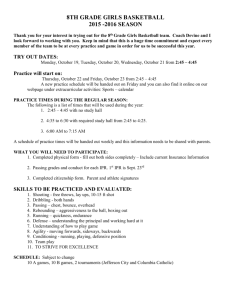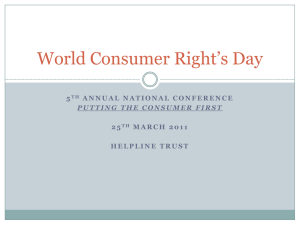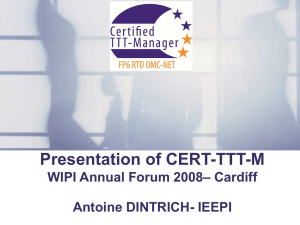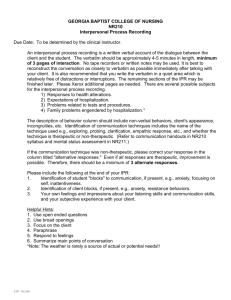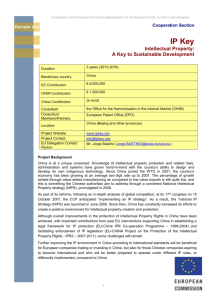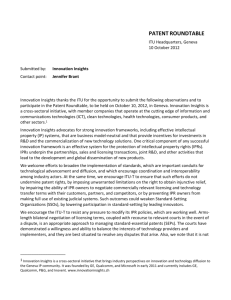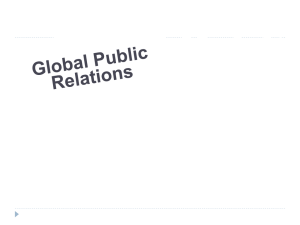Dignitary Presentations - American Intellectual Property Law
advertisement
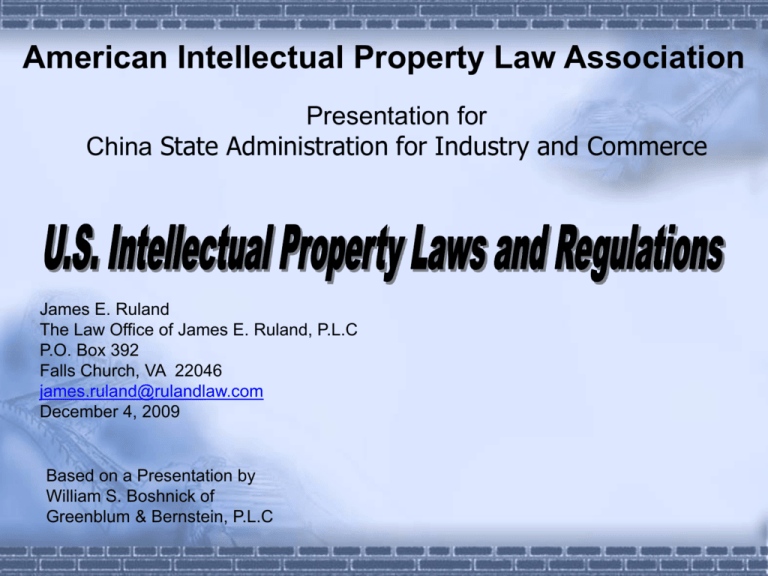
American Intellectual Property Law Association Presentation for China State Administration for Industry and Commerce James E. Ruland The Law Office of James E. Ruland, P.L.C P.O. Box 392 Falls Church, VA 22046 james.ruland@rulandlaw.com December 4, 2009 Based on a Presentation by William S. Boshnick of Greenblum & Bernstein, P.L.C Overview of Organization of U.S. Law Legislative Branch (U.S.C.) • Congress Makes the Laws Executive Branch (C.F.R.) • President Executes the Laws Judicial Branch • Courts Interpret and Enforce the Laws December 4, 2009 Overview of Organization of U.S. Law Federal Court System • • • • District Courts Courts of Appeal Supreme Court Similar State Court Structure Trade Secrets Rights of Publicity Regulatory Agencies • United States Patent and Trademark Office (USPTO) • Library of Congress (Copyright Office) • International Trade Commission (ITC) December 4, 2009 Intellectual Property Intangible Property • Applied Ideas Patents • Fixed Works of Authorship Copyright • Commercial Sources Trademark December 4, 2009 Patents 专利 Patent Law U.S. Government Grant • Right to exclude others • Not a right to do (or make) something • Not a Natural Right Limited Right • In Time and Scope • Violation of Right is Infringement December 4, 2009 Patent Law Provided in the United States Constitution (est. 1787) Congress has the power “to promote the progress of Science and useful Arts, by securing for limited times to Authors and Inventors the exclusive Right to their respective Writings and Discoveries.” Article 1, Section 8, Clause 8 December 4, 2009 Patentability of Invention Useful: “Any new and useful process, machine, manufacture, or composition of matter, or any new useful improvement thereof, may obtain a patent therefor…” (35 U.S.C. § 101) New (35 U.S.C. § 102) Nonobvious (35 U.S.C. § 103) December 4, 2009 Unpatentable Subject Matter Algorithms Mental processes Mathematical formulas Phenomena of nature Fundamental truths December 4, 2009 Patent Application An application is usually prepared by an attorney or agent who is admitted to practice before the United States Patent and Trademark Office (USPTO), but inventor may apply on his own (pro se). Types of patents: • Utility patent • Design patent • Plant December 4, 2009 Prosecution Average time from filing to first examination in PTO: • 1.5 - 5 years (depending on the type and field of the application), sometimes longer The delay in processing applications is expected to increase due to the huge application backlog in the PTO December 4, 2009 Issuance For utility applications filed on or after June 8, 1995, the patent term is generally 20 years from the filing date, or any earlier filing date claimed under 35 U.S.C. § 119 20 years December 4, 2009 Enforcement Patent claims define scope of invention Right to exclude others Notice by patent marking December 4, 2009 Copyrights 著作权 © Copyright Law 1. Government Grant • Like Patent, Not a Natural Right • Constitution 2. Limited in; • Extent • Time • Generally life of the author +70 years • Scope December 4, 2009 Copyright: Laws and Rules Constitution Statutes – Title 17 United States Code Rules – Title 37 Code of Federal Regulations §201 Federal Law • Cases, Precedence December 4, 2009 What is a Copyright? Authors of “original works of authorship” Exclusive rights, 17 U.S.C. § 106 • Reproduce Copies of Works • Prepare Derivative Works • Perform and Display Certain Works Limitations, 17 U.S.C. §§ 107-121 • Fair Use • Reproduction by Libraries • Reproduction for Blind and Disabled December 4, 2009 What is a Copyright? Must be fixed on a tangible medium Original or independent authorship and… Some minimal level of creativity Feist Publications, Inc. v. Rural Telephone Service Co., 499 U.S. 340 (1991) December 4, 2009 What Exclusive Rights are Given to Authors? Right to Exclude Others • From protected expression • Not from idea or concept Enumerated in 17 U.S.C. § 106 Limited by various compulsory licenses and exemptions in 17 U.S.C. §§ 107-121 December 4, 2009 Fair Use Limitation 17 U.S.C. § 107 Use does not infringe if for purposes of • • • • • • December 4, 2009 Criticism Comment News reporting Teaching Scholarship Research Enforcement Must Demonstrate 1. Ownership of a valid copyright, and… 2. Copy of the original, whole or in substantial part Direct Infringement • Direct Evidence Admissions, secret codes copied • Circumstantial evidence December 4, 2009 Access Substantial similarity Trademarks 商标 Trademark Law 1. Commercial Right 2. Limited Right • Scope • Indefinite in duration if in continuous use December 4, 2009 Public Policy Protection of Commerce Consumer • Prevent deception and confusion • Source of goods trusted Manufacturer • Identification of their goods • Prevent diversion of customers Competitors • Prevent undue monopolization of effective symbols and signs General Public • Reward producers of goods • Minimize consumer deception December 4, 2009 Trademark: Laws and Rules State Laws Federal Statutes (15 U.S.C.) • Lanham Act • Antidilution Rules Guidelines • Trademark Manual Examination Procedure December 4, 2009 What are Trademarks and Service Marks? Trademark is any word, phrase, symbol or combination thereof which is used by a manufacturer or merchant to identify its goods and distinguish them from those manufactured and sold by others. Service Mark is any word, name, symbol or combination thereof which is used in the sale or advertising of services to identify the services and distinguish them from those of others. December 4, 2009 Advantages of Promoting Trademarks Attracts Attention Symbolizes quality and promotes goodwill for the owner Conditions consumers response to automatically recognize owner December 4, 2009 Trademark Enforcement Registered Mark Infringement • Confusion, mistake, deception • Section 32 of Lanham Act Violation of Section 43(a) of Lanham Act • Confusion, mistake, deception or • Misrepresentation False Advertising Common Law Actions • Trademark, trade dress • Unfair business practices December 4, 2009 Summary: Intellectual Property Patents: Strong Exclusionary Right, Cover Ideas Copyrights: Strong Exclusionary Right, Cover Expressions Trademarks: Strong Exclusionary Right, Cover Marketing December 4, 2009 Questions? Special Thanks to William S. Boshnick of Greenblum & Bernstein, P.L.C. James E. Ruland The Law Office of James E. Ruland, P.L.C P.O. Box 392 Falls Church, VA 22046 james.ruland@rulandlaw.com U.S. Intellectual Property Laws in International Trade AIPLA Presentation for China State Administration for Industry and Commerce Kevin C. Kunzendorf Sughrue Mion, PLLC 2100 Pennsylvania Ave., NW Washington, DC 20037 kkunzendorf@sughrue.com Outline Preventing intellectual property right (IPR) problems in international trade When IPR problems occur – U.S. framework and options for addressing IPR problems Prevention of IPR Problems Knowledge of the activity or product Knowledge of target country’s legal system and IP laws • Team of advisors in target country Attorneys Business people Prevention of IPR Problems Understand what IPR exists in the target country • Search of relevant IPR databases • Seek opinions from advisors Negotiate licenses if necessary IPR Problems – U.S. Framework Alternative Dispute Resolution (ADR) U.S. District Court U.S. International Trade Commission (USITC) IPR Problems – U.S. Framework Alternative Dispute Resolution (ADR) • Seeks alternatives to litigation • Neutral party facilitates communication • Binding or non-binding IPR Problems – U.S. Framework Alternative Dispute Resolution (ADR) • AIPLA Alternative Dispute Resolution Neutral Registry • WIPO Arbitration and Mediation Center IPR Problems – U.S. Framework Alternative Dispute Resolution (ADR) • Advantages Relatively inexpensive Trained, neutral parties Can help initiate and sustain communications IPR Problems – U.S. Framework Alternative Dispute Resolution (ADR) • Disadvantages Parties may not be willing to submit to ADR, specifically binding ADR Requires trust in the neutral party Effectiveness determined by willingness of the parties to actively participate in the process Even if successful, ADR may not completely resolve the problem. IPR Problems – U.S. Framework U.S. District Court • 94 federal judicial districts U.S. Court of Appeals • 12 regional circuits IPR Problems – U.S. Framework U.S. District Court • General trial courts Both civil and criminal matters Criminal cases have priority Civil cases can take a long time IPR Problems – U.S. Framework U.S. District Court • Parties Plaintiff (the aggrieved party) Defendant (the importing party) District Court Judge Jury (?) IPR Problems – U.S. Framework U.S. District Court – key features • Case initiated by filing a complaint, which is a formal document submitted to the district court. Must show legal injury of plaintiff by defendant (that is, infringement of plaintiff’s IPR by defendant) May be problematic if trade goods are outside U.S. or in transit IPR Problems – U.S. Framework U.S. District Court – key features • Court must have jurisdiction (power) over persons and subject matter Federal statutory questions (patent, copyright, trademark – ok) May be problematic in some cases (e.g., license interpretation) Parties from different states May be problematic if defendant is wholly outside of US borders IPR Problems – U.S. Framework U.S. District Court – key features • Scheduled process Defendant’s answer to allegations in the complaint Discovery to uncover facts for trial Expert witnesses Trial IPR Problems – U.S. Framework U.S. District Court – key features • Possibility of a jury Hears testimony Weighs factual evidence Decides factual issues, such as credibility of witnesses • Jury has little or no technical background Uncertainty IPR Problems – U.S. Framework U.S. District Court – Process • District court judge Oversees all aspects of case Written opinion deciding legal issues Order directing remedies • Decision may be appealed U.S. Court of Appeals of the region in which the district court is located U.S. Court of Appeals for the Federal Circuit IPR Problems – U.S. Framework U.S. District Court – remedies • Monetary damages Compensatory Treble damages for willful infringement Attorney’s fees • Injunctive relief to stop infringer from infringing, and prevent future infringement Temporary or permanent IPR Problems – U.S. Framework U.S. District Court • Advantages Parties must participate Court order is binding Injunctive relief and monetary damages possible IPR Problems – U.S. Framework U.S. District Court • Disadvantages Jury is unpredictable Takes a long time Very expensive IPR Problems – U.S. Framework United States International Trade Commission (USITC) • USITC is an independent government agency • Section 337 of the 1930 trade law – protect against “unfair competition in import trade” IPR Problems – U.S. Framework USITC – over 500 cases since 1974 IPR Problems – U.S. Framework USITC – Role • USITC investigates unfair acts or methods of competition connected to importation “Statutory” unfair acts – U.S. patent, trademark, copyright, and mask work infringement Other unfair acts – E.g. anti-dumping, trade secret misappropriation IPR Problems – U.S. Framework USITC § 337 action • Parties Complainant (that is, the “aggrieved” party) Respondent (that is, the “importing” party) Staff Attorney from the ITC’s Office of Unfair Import Investigations (OUII) Administrative Law Judge (ALJ) IPR Problems – U.S. Framework USITC § 337 action • OUII Staff Attorney Independent, separate third part Experienced in IP law, usually technically background Protects the interest of the public when considering the affects of the investigation on the U.S. trade industry and economy. Helps with procedural issues; provides “sounding board” IPR Problems – U.S. Framework USITC § 337 action – key features • Jurisdiction In rem, which means it is focused on importation of products, as opposed to the acts or presence of persons. IPR Problems – U.S. Framework USITC § 337 action – key features • Importation Complainant must show importation of a product connected to the alleged unfair act in order to satisfy subject matter jurisdiction. • Domestic industry Economic showing: Requires showing substantial U.S. exploitation of the intellectual property by use of U.S. land, labor, and capital in production-type activities Technical showing: Complainant or licensee practices the IPR IPR Problems – U.S. Framework USITC § 337 action - process • Complaint reviewed and initiated by the Commission • Chief ALJ assigns the investigation to an ALJ and a OUII Staff Attorney IPR Problems – U.S. Framework USITC § 337 action - process • Proceedings before the ALJ Discovery Hearing (that is, a trial) • The ALJ Issues an “Initial Determination (ID)” on the merits of all contested issues IPR Problems – U.S. Framework USITC § 337 action • The ID is reviewed by the Commission and the Commission issues a Final Determination ID affirmed ID reversed, and/or sent back to ALJ • Commission also issues a decision on remedy and bonding IPR Problems – U.S. Framework USITC § 337 action • Remedies Exclusion order, which is an order prohibiting importation into the U.S. of infringing products Enforced by U.S. Customs at the U.S. border Temporary or permanent IPR Problems – U.S. Framework USITC § 337 action • Remedies Cease and Desist order, which prevents any parties from engaging in infringing activities related to products that have already been imported. Instead of or in addition to exclusion order Temporary or permanent NO monetary damages IPR Problems – U.S. Framework USITC § 337 action • President has 60 days to review the final determination of the Commission • Possible to appeal the final determination to the U.S. Court of Appeals for the Federal Circuit IPR Problems – U.S. Framework USITC § 337 action • Investigations 1995-2002 (102) Violation 23% No Violation 17% Withdraw/ Dismiss 11% Settlement/ Consent Order 49% IPR Problems – U.S. Framework USITC • Advantages Parties must participate Relatively quick resolution (12-15 months) Injunctive and temporary relief available to stop infringement of IPR in the U.S. Broad jurisdiction – in rem (that is, power over the property) U.S. Customs enforcement of decision IPR Problems – U.S. Framework USITC • Disadvantages Fast, invasive discovery Still expensive – high costs in short period No damages or attorney’s fees Thank you! Questions? Kevin C. Kunzendorf Sughrue Mion, PLLC 2100 Pennsylvania Ave., NW Washington, DC 20037 kkunzendorf@sughrue.com
